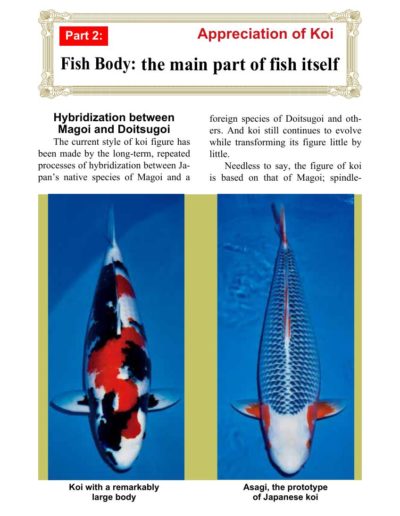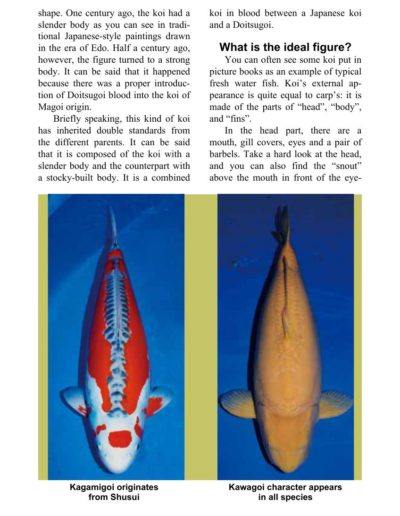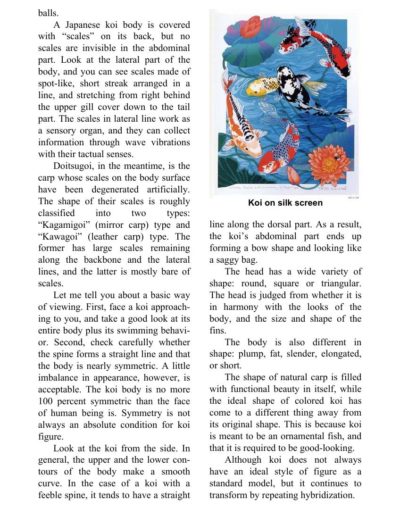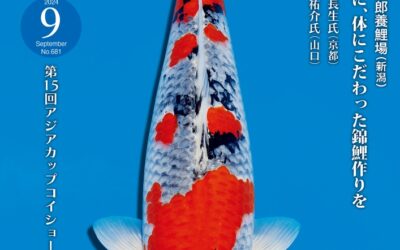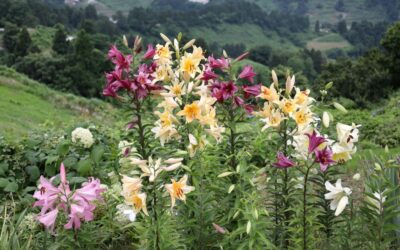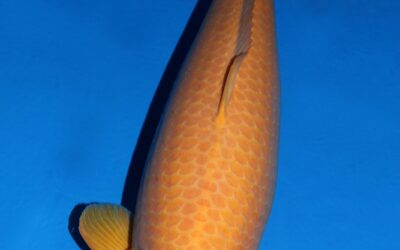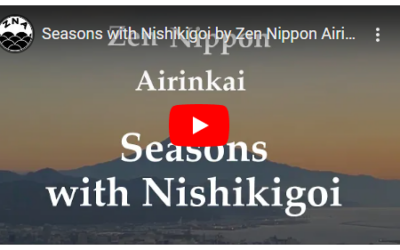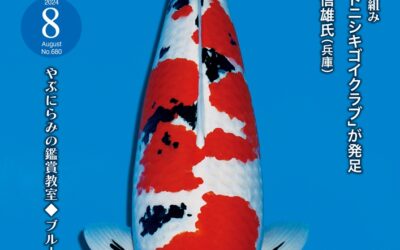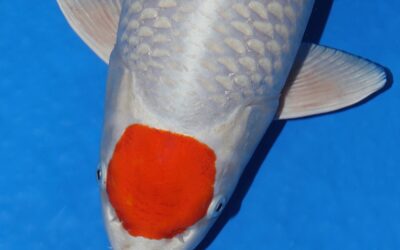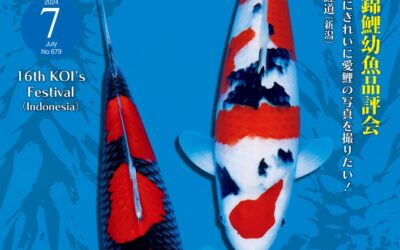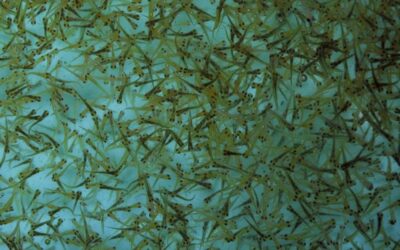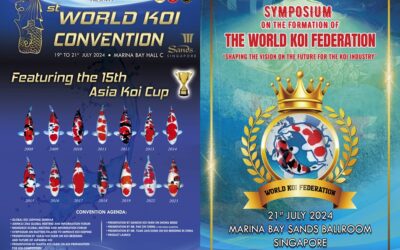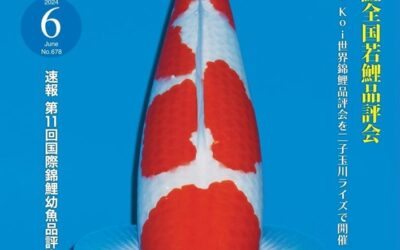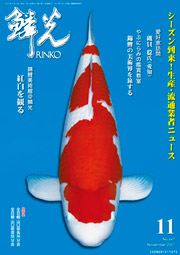Appreciation of Koi Part 2:
Fish Body: the main part of fish itself
Hybridization between Magoi and Doitsugoi
The current style of koi figure has been made by the long-term, repeated processes of hybridization between Japan’s native species of Magoi and a foreign species of Doitsugoi and others. And koi still continues to evolve while transforming its figure little by little.
Needless to say, the figure of koi is based on that of Magoi; spindle-shape. One century ago, the koi had a slender body as you can see in traditional Japanese-style paintings drawn in the era of Edo. Half a century ago, however, the figure turned to a strong body. It can be said that it happened because there was a proper introduction of Doitsugoi blood into the koi of Magoi origin.
Briefly speaking, this kind of koi has inherited double standards from the different parents. It can be said that it is composed of the koi with a slender body and the counterpart with a stocky-built body. It is a combined koi in blood between a Japanese koi and a Doitsugoi.
What is the ideal figure?
You can often see some koi put in picture books as an example of typical fresh water fish. Koi’s external appearance is quite equal to carp’s: it is made of the parts of “head”, “body”, and “fins”.
In the head part, there are a mouth, gill covers, eyes and a pair of barbels. Take a hard look at the head, and you can also find the “snout” above the mouth in front of the eyeballs.
A Japanese koi body is covered with “scales” on its back, but no scales are invisible in the abdominal part. Look at the lateral part of the body, and you can see scales made of spot-like, short streak arranged in a line, and stretching from right behind the upper gill cover down to the tail part. The scales in lateral line work as a sensory organ, and they can collect information through wave vibrations with their tactual senses.
Doitsugoi, in the meantime, is the carp whose scales on the body surface have been degenerated artificially. The shape of their scales is roughly classified into two types: “Kagamigoi” (mirror carp) type and “Kawagoi” (leather carp) type. The former has large scales remaining along the backbone and the lateral lines, and the latter is mostly bare of scales.
Let me tell you about a basic way of viewing. First, face a koi approaching to you, and take a good look at its entire body plus its swimming behavior. Second, check carefully whether the spine forms a straight line and that the body is nearly symmetric. A little imbalance in appearance, however, is acceptable. The koi body is no more 100 percent symmetric than the face of human being is. Symmetry is not always an absolute condition for koi figure.
Look at the koi from the side. In general, the upper and the lower contours of the body make a smooth curve. In the case of a koi with a feeble spine, it tends to have a straight line along the dorsal part. As a result, the koi’s abdominal part ends up forming a bow shape and looking like a saggy bag.
The head has a wide variety of shape: round, square or triangular. The head is judged from whether it is in harmony with the looks of the body, and the size and shape of the fins.
The body is also different in shape: plump, fat, slender, elongated, or short.
The shape of natural carp is filled with functional beauty in itself, while the ideal shape of colored koi has come to a different thing away from its original shape. This is because koi is meant to be an ornamental fish, and that it is required to be good-looking.
Although koi does not always have an ideal style of figure as a standard model, but it continues to transform by repeating hybridization.
This article is originally from the issue No.668 (2016 Dec)
Enjoy our collection of articles on Japanese koi news, updates, winners, educational articles, definitions and more!
Join as a free RINKO Member for increased access and subscribe as a paid member for full access to our content.
World Nishikigoi Club
by RINKO online | Aug 30, 2024
Japanese RINKO 2024 September issue adverts
by RINKO online | Aug 19, 2024
Japanese RINKO 2024 September issue adverts 鱗光2024年9月号掲載広告
Notice of Office Closure
by RINKO online | Aug 12, 2024
Our office will be closed 8/11-18 for summer holidays. Please note that there...
muji-無地
by RINKO online | Aug 12, 2024
Muji 無地 Muji literally means "no pattern". As Nishikigoi terms, Muji stands...
ZNA The 60th Anniversary International Koi Show
by RINKO online | Jul 23, 2024
ZNA The 60th Anniversary International Koi ShowZNA The 60th Anniversary...
Japanese RINKO 2024 August issue adverts
by RINKO online | Jul 18, 2024
Japanese RINKO 2024 August issue adverts 鱗光2024年8月号掲載広告
Tancho 丹頂
by RINKO online | Jul 18, 2024
Tancho 丹頂 A rounded pattern named after Tancho crane that has a rounded red...
Japanese RINKO 2024 July issue adverts
by RINKO online | Jun 21, 2024
Japanese RINKO 2024 July issue adverts 鱗光 2024年7月号掲載広告 Japanese RINKO...
All Japan Koi Show Issues
by RINKO online | Jun 19, 2024
The koi show season in Japan is in break time waiting for the next season,...
Kego 毛子
by RINKO online | Jun 11, 2024
Kego 毛子 Newborn Nishikigoi. Baby fry just after hatching. ** 子 (ko) means...
15th Asia Cup Koi Show & 1st World Koi Convention in Singapore
by RINKO online | May 24, 2024
The big koi event happening in July in Singapore! DATE : 19th to 21st JULY...
Japanese RINKO 2024 June issue adverts
by RINKO online | May 24, 2024
Japanese RINKO 2024 June issue adverts 鱗光 2024年6月号掲載広告
RINKO Koi Magazine is NOW available online!
Blog Categories
Reminder: You must login or register for website to vote in our polls.
Recent Posts
Upcoming Events
Author: RINKO Online
RINKO was published in 1962 as the first Nishikigoi magazine in the world. Dr Takeo Kuroki organized Oita Airinkai (koi club) with 53 members. He wrote the most articles which were written on A5 size paper, printed in black and white and 28 pages long with his wife’s artwork on the front cover. When Dr Kuroki met our founder Shuji Fujita, they consulted on publishing his first book “Nishikigoi”. This created hundreds and thousands of “koi-kichi” (koi lovers/people crazy about koi). Their work together resulted in the success of RINKO Issue 15, the first cover printed in color. Since then their journey of introducing Nishikigoi culture to the world has blossomed.

